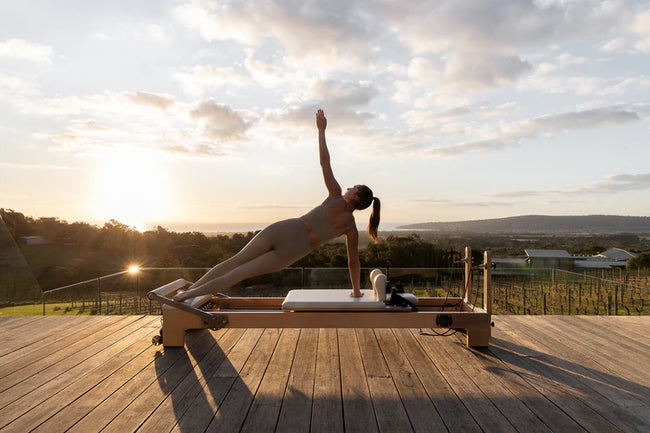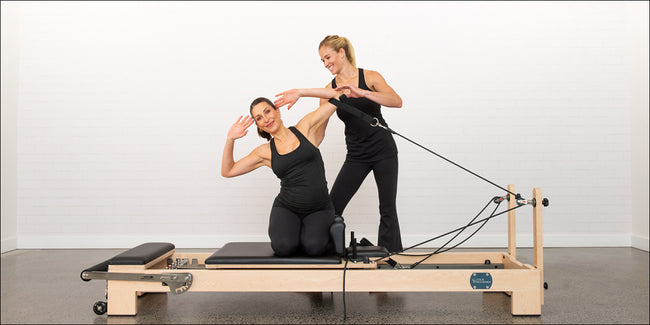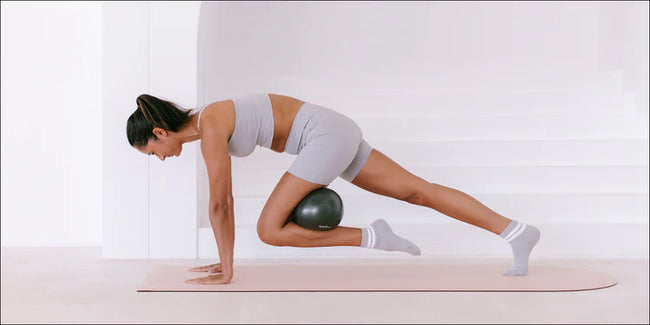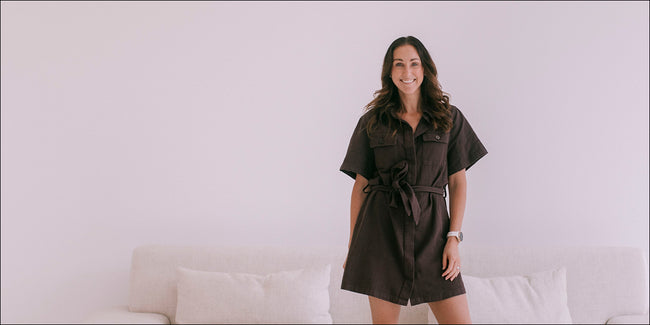We all have questions that pop up about Pilates, especially if we've not tried it before or are wanting to up our personal practice and reach new goals.
What is a Reformer?
A reformer bed is an apparatus that Joseph Pilates invented to support his Pilates repertoire. Essentially it's a bed with a movable platform (carriage), with springs and pulleys that add or remove resistance, and uses your body's movements to roll the carriage along the frame.
The reformer provides a great variety of exercises and increases the challenge using tension with springs.
How different is reformer Pilates to mat Pilates?
Both are based on the same core principles: concentration, control, centre, flow, precision and breathing. The main difference is the use of the reformer apparatus. Mat classes typically focus on the core predominantly, and can lack in variety of exercises in it's purest form. Using the reformer, we can focus on all muscle groups, not just the core, and build further on strengthening using springs for load. Traditionally, reformer Pilates was designed to build form and strength to enable one to progress to the matwork repertoire which can seem really challenging if you are weak in your core or lacking mobility. However reformer really does have many more benefits to this and is now far widely preferred for both modern and contemporary classes.
What are the main benefits of reformer Pilates?
So many – where to start?! It's great for building strength and muscle tone, as well as stability through the joints.
It connects the mind with your body’s movements, which essentially is a mindfulness practice, thereby helping to reduce stress and anxiety.
Originally designed for dancers, a reformer workout will focus on both strengthening and lengthening muscle movements, and it’s low impact so you can keep coming back. It’s very functional, building strength in the core which so many of us lack, thereby reducing the chance of back pain. It also helps to improve or counteract bad posture, for example the hunch back caused by sitting at a desk all day, breastfeeding or carrying children, looking over at our phones, etc. Plus it’s lots of fun.
Reformer Pilates is also great for rehabilitation. Clinical Pilates with a physio can really help you build strength and confidence back after an injury. The low impact nature of the exercises provide greater options to move than if you were nursing an injury in the gym.
What happens in a reformer class?
The focus for any class is first building strength in your core, but a reformer class also provides you with a full body workout. Some modern Pilates classes will incorporate props with your reformer workouts to spice things up and keep things interesting and challenging! It’s a lot of fun.
What should I be focusing on in my reformer Pilates class?
Form and technique is important for getting the greatest benefits from the exercise. Don’t push through an exercise if it doesn’t feel right. Be present in your body and focus on the movement and cues the instructor is giving you. Rushing an exercise is a common mistake, slowing it down can often reap greater rewards out of the exercise. And most of all, smile and have fun with it!
Will my body change through practicing reformer Pilates?
Pilates is not a weight loss focussed exercise but your body will definitely change. Improved posture WILL be a change. Longer and leaner bodies are the typical results you get from consistent Pilates practice. The time it takes to notice a difference, will depend on how consistent you are being, and how frequent. If you are consistently practicing 2-3 times per week, expect to notice a difference in about 4-6 weeks (although you will feel different earlier). Most clients feel they are more aware of what their body is doing and how it moves, they are more energised, alert and positive very early on, which carries them through to where they start to see physical changes. All of this leads on to better body confidence!
Pilates is easy! Isn't it?!
If you think Pilates is easy - you're doing it wrong. Sometimes small movements are the hardest. Focus on the detail and you'll shake to your core at even the most simple of Pilates sessions. We find our male customers often think it might not be challenging enough, are unsure about trying it with the stigma it’s a female-filled class, or don't think they're flexible enough and might embarrass themselves in front of others. We have so many of our customers feeding back to us that their partner has given it a go, in the comfort and privacy of their own home, and has loved it. They now have to fight over who gets to do a class first!
More and more athletes are taking up reformer Pilates to complement their strenuous training regime. It’s low impact which makes it great for longevity, however it will certainly get the body working. In particular, reformer Pilates is great for targeting muscle imbalances, and smaller muscle groups that can get neglected in traditional gym workouts. For this reason, clients often remark how difficult the class felt, because they were working on their areas of weakness.
I'm a beginner - where do I start with reformer Pilates?
Of course with any new exercise, if you have concerns or injuries, check-in with a health professional to get the green light. But the best way to start is with an introductory or beginner class. Perhaps you can find a local studio who offers an induction or introductory class, or, if you’re a YR customer, we have filmed introductory and beginner classes to ease you into via our OnDemand App. There’s a lot to learn in a reformer class and it can be overwhelming so the first thing really is familiarise yourself with the machine itself, then going over basic exercises to build confidence and form.
Am I really going to get as good results at home as I would in a studio?
Absolutely, in fact we’d argue more so. To get results, you need consistency, and really that is what we have been lacking mostly in the past couple of years with the pandemic. What having a reformer bed at home enables you to do is commit to more sessions per week. In-person sessions are excellent, the vibe and of course personal instruction to your form is not replicable; however you could keep your one class a week, and then supplement 2-3 extra classes at home that you may not have had time to get to otherwise. Plus you save $ too!
What do I need to prepare to have a reformer bed set-up at home?
The beds aren’t small, so make sure you measure your space and allow enough room either side for the exercises (ideally at least 75cm either side of the bed with some room at the end near the footbar). For those space conscious or in apartments, we have our Original Folding option which is ideal! We also recommend you create a ‘wellness sanctuary’. It doesn’t need to be anything fancy, but just little touches that will help motivate and inspire you to practice your Pilates. Then set a realistic schedule for yourself; are you a morning bod, or is evening after the kids in bed a better option? Do you have a partner or someone to support you if you need it so you can manage your workouts? And a good quality class instruction video to follow is important too, which our OnDemand App provides.









